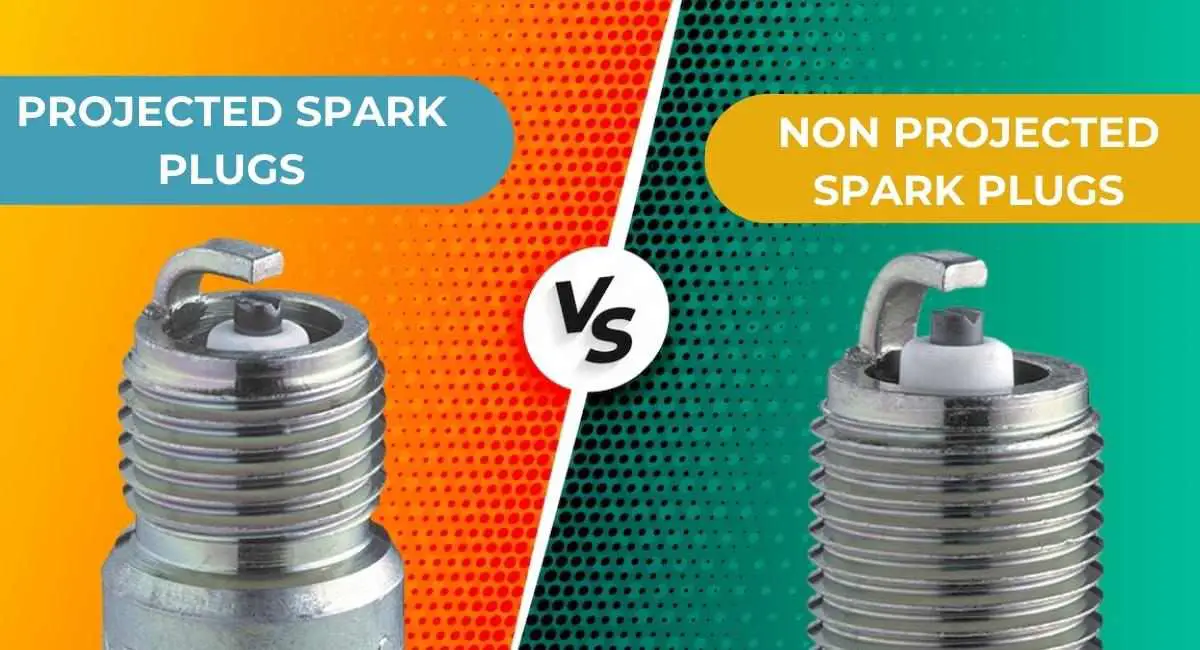When it comes to the smooth operation of an internal combustion engine, spark plugs play a crucial role in igniting the air-fuel mixture. While they may appear simple, spark plugs are sophisticated components with various design elements.
Projected and non-projected spark plugs represent two distinct approaches to achieving optimal combustion efficiency and power output. The tip design of a spark plug significantly influences the ignition process, flame propagation, and overall engine performance.
One key aspect that sets them apart is the type of tip they feature. In this comprehensive exploration of the battle of spark plugs, we will tackle the anatomy of a spark plug, focusing on projected vs. non-projected tip spark plugs and their impact on engine performance.
Anatomy of a Spark Plug
Before we dive into projected vs. non-projected tip spark plug differences, let’s take a moment to understand the basic anatomy of these essential engine components.
A spark plug consists of several key elements, including:
Shell: The outer metal body of the spark plug provides structural support and protection.
Insulator: The insulator location is inside the shell, typically made of ceramic material. It isolates the electrical charge from the shell and prevents it from leaking out prematurely.
Electrode: The electrode consists of two parts: the center and ground electrodes.
a . Center Electrode: Positioned at the spark plug’s center, it extends into the combustion chamber. The center electrode receives the electrical charge and generates the spark to ignite the air-fuel mixture.
b. Ground Electrode: The ground electrode’s position is opposite the center electrode. It provides a path for the spark to jump across the electrode gap and ignite the air-fuel mixture.
Tip: The tip of the spark plug is the area of the generation of sparks. It is exposed to the combustion chamber and plays a crucial role in initiating the combustion process.
These elements work together to create the electrical spark necessary for igniting the air-fuel mixture in an internal combustion engine. And the design of the spark plug tip can significantly influence the engine’s combustion characteristics, efficiency, and performance. Let’s explore two main types of spark plug tips: projected and non-projected.
Projected Spark Plugs
Projected spark plugs are characterized by their unique tip design extending beyond the electrode. This extension is commonly referred to as the “projected tip.” The projected tip serves several important functions in the ignition process.
Extending beyond the electrode, the projected tip positions the spark closer to the combustion chamber. This proximity allows for better flame propagation, resulting in improved combustion efficiency. The flame front travels faster, ensuring a complete burn of the air-fuel mixture. This can increase power output, fuel efficiency and reduce emissions.
Another advantage of projected spark plugs is their ability to reduce fouling. The extended tip prevents carbon buildup on the electrode, ensuring consistent spark performance over a longer period. This feature is particularly beneficial in engines operating under demanding conditions or frequently enduring stop-and-go driving.
Furthermore, projected spark plugs can provide better cold-start performance. The extended tip creates a larger surface area for the initial spark, aiding ignition during cold weather or in engines with poor fuel atomization.
Non-Projected Spark Plugs
Non-projected spark plugs feature a tip flush with the electrode. This design is more traditional and has been widely used in engines for many years. While non-projected spark plugs may not offer the same combustion efficiency level as projected ones, they still have advantages.
The flush tip design of non-projected spark plugs results in a different spark location within the combustion chamber. This altered spark position can influence flame propagation and combustion characteristics. Non-projected spark plugs are often preferred in engines with specific requirements, such as those operating at lower RPM ranges or in certain configurations with a desired combustion pattern.
Additionally, non-projected spark plugs can be more resistant to pre-ignition and detonation, especially in engines with high compression ratios or forced induction systems. The flush tip design allows for better heat dissipation, reducing the risk of hot spots and improving overall engine durability.

Electrode Types and Configurations
Spark plugs come in various electrode types and configurations, each with its characteristics and benefits. The choice of electrode material and configuration can significantly impact the performance and combustion efficiency of projected and non-projected spark plugs.
Electrode types:
- Copper: Copper is a common electrode material known for its excellent conductivity. It offers good heat dissipation but tends to wear out faster than other materials.
- Platinum: Platinum electrodes provide increased durability and a longer lifespan than copper. They also offer improved resistance to fouling and wear.
- Iridium: Iridium electrodes are known for their exceptional longevity and resistance to erosion. They provide a stable spark and excellent performance over an extended period.
Electrode Configurations
- Single Ground Electrode: This configuration features a single ground electrode opposite the center electrode. It is commonly used in non-projected spark plugs and provides a reliable spark.
- Multiple Ground Electrodes: Some projected and non-projected spark plugs have numerous ground electrodes. These additional electrodes promote a more even flame front and enhanced combustion efficiency.
The electrode type and configuration choice depend on engine requirements, operating conditions, and desired performance outcomes. Consulting with professionals or referring to the engine manufacturer’s recommendations is crucial to selecting the optimal electrode type and configuration for your specific application.
Heat Range of Spark Plugs and Its Influence on Performance
The heat range of a spark plug refers to its ability to dissipate heat generated during combustion. It plays a crucial role in engine performance, as an incorrect heat range can lead to various issues.
You can guarantee proper spark plug performance by selecting the appropriate heat range for an engine. For example, high-performance or forced induction configurations necessitate the use of spark plugs with a colder heat range to handle the increased heat produced effectively. On the other hand, engines operating under normal conditions might find spark plugs with a hotter heat range advantageous, as they can help prevent fouling and deposits during ignition.
Understanding Heat Range
The spark plug’s materials, design, and operating conditions determine the heat range. Depending on its ability to transfer heat away from the electrode, its category is hot, cold, or in-between.
Impact on Performance
- Hot Heat Range: Spark plugs with a hot heat range have a longer insulator nose, which allows them to retain more heat. They are ideal for engines operating under low-load conditions or in colder climates, as they help prevent fouling and misfires.
- Cold Heat Range: Spark plugs with a cold heat range dissipate heat more rapidly. They are suitable for high-performance engines, heavy loads, or engines with forced induction, as they help prevent pre-ignition and detonation.
Selecting the appropriate heat range for projected and non-projected spark plugs depends on factors such as engine type, compression ratio, operating conditions, and desired performance outcomes. It is crucial to consult with professionals or refer to the engine manufacturer’s recommendations to choose the correct heat range for your specific application.
Comparison of Projected and Non-Projected Spark Plugs
Now that we have examined the characteristics of projected vs. non-projected spark plugs individually, let’s compare the two types side by side to understand their strengths and weaknesses.
Performance and Combustion Efficiency
Projected spark plugs have the upper hand in terms of combustion efficiency. The extended tip promotes faster flame propagation and a more complete burn of the air-fuel mixture, resulting in increased power output and improved fuel efficiency. Non-projected spark plugs, while offering satisfactory performance, may achieve a different combustion efficiency level.
Fouling and Maintenance
Projected spark plugs have an advantage when it comes to fouling resistance. The extended tip design helps prevent carbon buildup on the electrode, ensuring consistent spark performance over a longer lifespan. Non-projected spark plugs are more susceptible to fouling, requiring frequent cleaning or replacement.
Application and Engine Requirements
The choice between projected and non-projected spark plugs ultimately depends on the specific engine requirements and operating conditions. Projected spark plugs are often preferred in high-performance engines or those that demand maximum efficiency.
On the other hand, non-projected spark plugs are common in engines with lower RPM ranges or specific combustion requirements.
It is important to note that the choice of spark plug type also depends on the engine’s ignition system, fuel quality, and other factors. Consulting with professionals or referring to the engine manufacturer’s recommendations is always advised when selecting the appropriate spark plug type for your specific application.
Important Read: A Comparison of Bosch Double Iridium vs NGK Laser Iridium
Conclusion
In the battle of spark plugs, the debate between projected and non-projected tips is ongoing, with each type offering unique advantages and considerations for engine performance and combustion efficiency. Choosing the right spark plug depends on engine requirements, operating conditions, and desired outcomes. Projected spark plugs excel in combustion efficiency and fouling resistance, while non-projected spark plugs have their advantages in specific engine needs and heat dissipation. It is crucial to consider your engine’s requirements and seek professional advice for an informed decision. With advancing technology, spark plug designs will continue to evolve, offering improved performance and efficiency.
